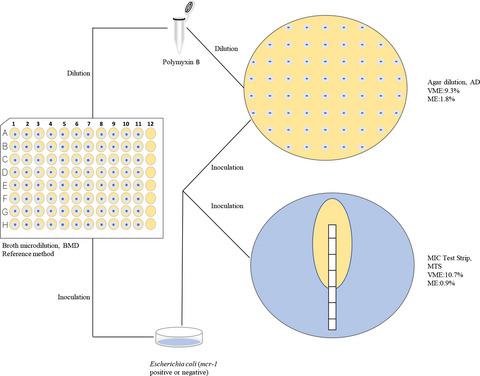当前位置:
X-MOL 学术
›
Lett. Appl. Microbiol.
›
论文详情
Our official English website, www.x-mol.net, welcomes your
feedback! (Note: you will need to create a separate account there.)
Performance of different methods for testing polymyxin B: comparison of broth microdilution, agar dilution and MIC test strip in mcr-1 positive and negative Escherichia coli
Letters in Applied Microbiology ( IF 2.0 ) Pub Date : 2021-04-27 , DOI: 10.1111/lam.13492 Y Wang 1 , B Berglund 1, 2 , Y Zhu 1 , Q Luo 1 , Y Xiao 1
Letters in Applied Microbiology ( IF 2.0 ) Pub Date : 2021-04-27 , DOI: 10.1111/lam.13492 Y Wang 1 , B Berglund 1, 2 , Y Zhu 1 , Q Luo 1 , Y Xiao 1
Affiliation

|
Antimicrobial susceptibility testing with the last-resort antibiotics polymyxins (polymyxin B and colistin) is associated with several methodological issues. Currently, broth microdilution (BMD) is recommended for colistin and polymyxin B. BMD is laborious and the utility of alternative methods needs to be evaluated for polymyxin B susceptibility testing. In this study, using BMD as a reference method, the performance of agar dilution (AD) and MIC test strips (MTS) were evaluated in polymyxin B susceptibility testing. BMD, AD and MTS were used to determine MICs of 193 clinical isolates of Escherichia coli. Seventy-nine were positive for the polymyxin resistance gene mcr-1. Method performances were evaluated based on pair-wise agreements with the reference method (BMD) and statistical testing. AD and MTS showed an unacceptable number of very major errors (VMEs) compared with BMD, 9·3 and 10·7%, respectively. The essential agreement (EA) was low for AD (49·7%), but high for MTS (97·8%). However, statistical testing showed that MTS tended to yield a one-step lower MIC (P < 0·01) compared with BMD. The discordances observed with MTS and AD in comparison with BMD for polymyxin B susceptibility testing for E. coli suggest their inapplicability in routine testing. A large number of isolates clustered around the susceptibility breakpoint (2–4 mg l−1) and several mcr-1 positive isolates (17%) were determined as susceptible with BMD. A screening breakpoint for mcr-1 of 2 mg l−1 should also be considered.
中文翻译:

多粘菌素 B 不同检测方法的性能:肉汤微量稀释、琼脂稀释和 MIC 试纸条在 mcr-1 阳性和阴性大肠杆菌中的比较
使用最后的抗生素多粘菌素(多粘菌素 B 和粘菌素)进行抗菌药物敏感性测试与几个方法学问题有关。目前,建议对粘菌素和多粘菌素 B 使用肉汤微量稀释 (BMD)。BMD 很费力,需要评估替代方法的效用,以进行多粘菌素 B 敏感性测试。在本研究中,使用 BMD 作为参考方法,在多粘菌素 B 敏感性测试中评估了琼脂稀释 (AD) 和 MIC 试纸 (MTS) 的性能。BMD、AD 和 MTS 用于确定 193 株大肠杆菌临床分离株的 MIC 。79 人对多粘菌素抗性基因mcr-1呈阳性. 方法性能根据与参考方法 (BMD) 和统计测试的成对协议进行评估。与 BMD 相比,AD 和 MTS 显示出不可接受的非常大错误 (VME) 数量,分别为 9·3 和 10·7%。AD 的基本一致性 (EA) 较低 (49·7%),但 MTS 的基本一致性 (EA) 较高 (97·8%)。然而,统计测试表明, 与 BMD 相比,MTS 倾向于产生一个低一级的 MIC ( P < 0·01)。与E 的多粘菌素 B 敏感性测试相比,MTS 和 AD 与 BMD 观察到的不一致。 大肠杆菌表明它们在常规测试中不适用。大量分离物聚集在易感性断点 (2–4 mg l -1 ) 和几个mcr-1 附近阳性分离株 (17%) 被确定为对 BMD 敏感。还应考虑mcr-1的筛选断点为2 mg l -1。
更新日期:2021-04-27
中文翻译:

多粘菌素 B 不同检测方法的性能:肉汤微量稀释、琼脂稀释和 MIC 试纸条在 mcr-1 阳性和阴性大肠杆菌中的比较
使用最后的抗生素多粘菌素(多粘菌素 B 和粘菌素)进行抗菌药物敏感性测试与几个方法学问题有关。目前,建议对粘菌素和多粘菌素 B 使用肉汤微量稀释 (BMD)。BMD 很费力,需要评估替代方法的效用,以进行多粘菌素 B 敏感性测试。在本研究中,使用 BMD 作为参考方法,在多粘菌素 B 敏感性测试中评估了琼脂稀释 (AD) 和 MIC 试纸 (MTS) 的性能。BMD、AD 和 MTS 用于确定 193 株大肠杆菌临床分离株的 MIC 。79 人对多粘菌素抗性基因mcr-1呈阳性. 方法性能根据与参考方法 (BMD) 和统计测试的成对协议进行评估。与 BMD 相比,AD 和 MTS 显示出不可接受的非常大错误 (VME) 数量,分别为 9·3 和 10·7%。AD 的基本一致性 (EA) 较低 (49·7%),但 MTS 的基本一致性 (EA) 较高 (97·8%)。然而,统计测试表明, 与 BMD 相比,MTS 倾向于产生一个低一级的 MIC ( P < 0·01)。与E 的多粘菌素 B 敏感性测试相比,MTS 和 AD 与 BMD 观察到的不一致。 大肠杆菌表明它们在常规测试中不适用。大量分离物聚集在易感性断点 (2–4 mg l -1 ) 和几个mcr-1 附近阳性分离株 (17%) 被确定为对 BMD 敏感。还应考虑mcr-1的筛选断点为2 mg l -1。









































 京公网安备 11010802027423号
京公网安备 11010802027423号